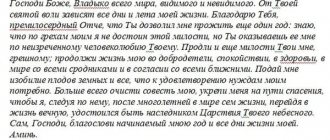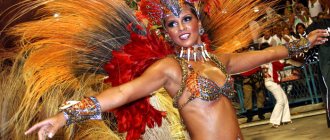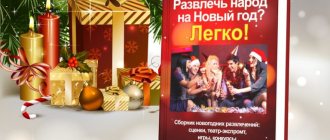New Year
New Year is the most favorite holiday of most of our compatriots, young and old. Almost all Russian families celebrate it grandly. On this day, it is customary for the whole family to gather around a large table, thanks to which it is perceived as the most homely, family-friendly and kind. Adults become children and are absolutely confident in a miracle. The New Year is both the end and the beginning of a new stage in life; people involuntarily think about the period they have lived, remember successes, analyze the reasons for failures, make plans for the future and, of course, dream.
It is remarkable that the tradition of celebrating the arrival of the new year existed among ancient peoples even before the advent of our era, and January 1 was “designated” as the first calendar day in ancient Rome. It is symbolic that the name of the month comes from the name of the god Janus, whom the ancient Romans depicted as having two faces: one of his faces looked back, and the other looked exclusively forward.
The Gregorian calendar, according to which most countries count weekdays and holidays, is, however, not accepted everywhere. There are a number of states that celebrate the New Year according to the lunar calendar:
- Vietnam,
- Israel,
- China,
- Korea,
- Mongolia,
- Thailand,
- Cambodia,
- Sri Lanka,
- as well as the inhabitants of Tibet and the Deccan Plateau in India, a majority Muslim country.
In Rus', until the 15th century, the New Year, according to the Julian calendar, was celebrated in March, on the day of the spring equinox. In the 15th century, the “first day of the year” was moved to September 1. Only in the era of Peter I the new year began to begin on January 1.
At the end of the 19th century, it ceased to be a worker, and in Stalin’s times, Soviet citizens began to work again on this day. Only after the end of the Great Patriotic War did January 1 become a day off again. In the early 90s, January 2 was added to 1, and at the beginning of 2000, the New Year public holiday was celebrated by Russian residents on vacation, during the first five days of January. Since 2013, January 6 and 8 have been added to the Russian New Year holidays.
At this time, traditionally, New Year trees are decorated in houses, festive dishes are prepared, Santa Claus is awaited, and to the chime of the Kremlin chimes everyone raises glasses of champagne and makes secret wishes that will certainly come true in the coming year.
Calendar rituals
The folk calendar intertwines Christian and pagan holidays, which are celebrated annually by the Russian people. They preserve the traditions of ancient cults and rituals that honor their ancestors.
Important! In Rus', the folk calendar was called the monthly calendar. It covered the entire year, where holidays, everyday life, traditions, customs, superstitions, rituals, phenomena, folk signs that manifested themselves in a given month or day were described.
The Monthly Word became a fusion of two principles: Christian and pagan.
Christmas
Most countries in the world, including Russia, celebrate the Christian church holiday of Christmas at the state level. In addition to the fascinating church rituals and services, numerous secular traditions of celebrating the birth of the Savior are widespread in our country.
January 7 became an official state holiday back in the 10th century. In the 17th-18th centuries, the tradition of the Christmas nativity theater came to Russia from the West; at the end of the 19th century, it was already common to decorate the Christmas tree, and at the beginning of the 20th, Father Frost began to come to Russian children with gifts.
For a long time, the Soviet government considered Christmas an alien celebration. Only in 1935, Christmas traditions were transformed into New Year's ones and returned to the Soviet people. In 1937, the heroine of the Russian folk tale, the Snow Maiden, who left the stage of the country's main Christmas tree, became an integral character in the script. Christmas became an official public holiday in Russia in 1991.
On the eve and after Christmas, it is customary to sing carols: boys and girls in disguise go from house to house and sing carols, and the owners thank them with all sorts of goodies and money. This custom was introduced from pagan traditions and has survived to this day. This is where the rule came from on Holy Evening to bring fragrant kutia to the houses of the godparents.
On the Bright Holiday, baked pig or goose, as well as many other unusual dishes, were served on the festive table. Christmastide begins with Christmas and lasts until Epiphany.
Cover
The Protection of the Most Holy Theotokos was one of the main autumn celebrations for the Russian people. This is the best time for viewings and weddings. The holiday is celebrated on October 14 (1 according to the old style).
Image of the Most Pure Virgin covering the people with her headscarf
According to the church calendar, the Intercession was celebrated in memory of the miraculous appearance of the Mother of God at the walls of Constantinople, cordoned off by the Saracens. The Mother of God covered the city with her cloak and saved it from ruin.
Important! In the Slavic calendar, October 1 meant the end of agricultural work and the beginning of winter.
Defender of the Fatherland Day
On February 23, Russian families celebrate an important public holiday - Defender of the Fatherland Day. Many former members of the Soviet Union on the territory of new states have established their own alternative dates, but their residents still congratulate their men on February 23.
The Day of the Soviet Army and Navy in the USSR began to be celebrated starting in 1922 in honor of the 5th anniversary of the creation of the Red Army. On this day in 1918, the Soviet government proclaimed the need to create its own military structure, and the date itself became the birthday of the armed forces of post-revolutionary Russia.
On February 23, it is customary to congratulate all men, as well as women military personnel and military veterans. In Moscow, memorial wreaths are solemnly laid at the Tomb of the Unknown Soldier, and the evening sky over the city is illuminated by festive fireworks.
Ivana Kupala
The Nativity of John the Baptist or the holiday of Ivan Kupala has been considered one of the most riotous and cheerful since ancient times.
On the night before the holiday, young people wove wreaths for themselves, then threw them into the water, lit fires, jumped over them, and danced in circles.
Girls lower wreaths into the water
It was believed that on Ivan Kupala nature reveals all its life-giving powers. At midnight the fern blooms, and the one who finds it becomes all-seeing and begins to understand the language of plants and animals.
International Women's Day
Probably everyone knows that the tradition of celebrating women's holiday appeared after the protest of American women workers against harsh working conditions. The indignation of their overseas colleagues was actively supported by European communists - fighters for women's rights.
Until the 20s of the 20th century, in America and Europe there was a boom in holding various events that attracted the public to women's problems. In Russia, fashionable, enlightened ladies of St. Petersburg first celebrated this day in 1913. Since 1921, the party and government have made the celebration of March 8 a state celebration with overtly political overtones. Wise time has preserved a wonderful holiday in the form of All Women's Day in the first days of the long-awaited spring.
Wedding traditions
Since the end of the 9th century, when Christianity was proclaimed, traditional Russian wedding ceremonies and church wedding rites began to take shape. The ancient wedding ritual with certain stages, paraphernalia, clothing, and treats was finally formed in the 16th century.
Russian wedding
The newlyweds were protected with the help of numerous amulets, amulets, embroidery on clothes, and lit candles.
A wedding, like birth and funeral, was considered a kind of transition in a person's life. The holiday consists of stages:
- Matchmaking.
- Engagement.
- “Purchasing” a bride.
- Wedding.
- Partying and feasting.
- Second wedding day.
The whole process took from a week to three months. Relatives and friends of the newlyweds took part.
Labour Day
The infamous demonstration of workers in Chicago on May 1, 1886, demanding a reduction in the working day to 8 hours became the starting point in the tradition of holding demonstrations on this day of workers defending their rights. For many decades, the meaning of May Day was interpreted in the light of the irreconcilability of class confrontation.
Modern people of different professions in 66 countries of the world consider this holiday deeply theirs. In the territory of the former Soviet Union, on May 1, it is customary for large families and noisy groups to gather, go out into nature, cook barbecue and enjoy the first warm days.
Rituals
All rituals in Rus' were dedicated to important events in a person’s life. The naming ritual was considered one of the most important, since the Russians believed that a person’s entire life depended on the name.
Naming
The Slavs believed that the name determines the future fate of a person, and also protects him from evil spirits. The naming ceremony could be performed several times for one person. The first name was given to the child by the father at birth. At a young age, the name was changed - the priests washed the teenagers in sacred waters, ridding them of childhood sins. Also, the name was changed during marriage, during illness or as a result of heroic deeds.
For boys, this ceremony took place only in the river, and for girls - in a river or lake. The person being named had to hold a burning candle in his hand. After the priest’s words, one had to plunge one’s head into the water and hold the candle at arm’s length.
Fraternization
Among pagan customs, the ritual of fraternization, during which warriors exchanged crosses, was popular. In this way, the warrior made it clear to his comrade that he honors him as a warrior and considers him his brother. When exchanging crosses, a person swore an oath to a friend that he could always be relied upon.
Wedding
Among the ancient Slavs, a wedding was accompanied by many rituals from the moment of preparation. During the engagement, the newlyweds had to wash each other with decoctions of medicinal herbs in order to cleanse themselves of sins before marriage. For the wedding ceremony, the bride was dressed in a white shirt with special symbols.
Karavai was present at every wedding. It had to be round in shape so that the young people would live well and satisfyingly. Relatives were invited using a special ritual called requestin, and the mother escorted her son to the new home with the help of prayers. The groom's family had to give a ransom for the bride, and the girl's parents prepared a decent dowry. There were several ransoms at the wedding, and they ended with a toast. During the celebration, the bride's braid was unraveled or cut off and her head was covered with a cap - a symbol of marriage.
After the exchange of rings, the following folk rituals began:
- posag – transfer of dowry;
- komora - checking the bride for purity and preparing for the first wedding night;
- matchmakers - newlyweds treated relatives and accepted gifts from guests.
tonsure
The ancient rite of tonsure was carried out in honor of the separation of a child from his mother. From early childhood, the mother helped the baby learn about the world and formed his understanding of the world around him. Men began to take care of their sons only after tonsure. Until this time, the child was considered a fragile creature, not adapted to life. Men had to instill in the boy the role of a man, teach him hunting, fishing, crafts and military affairs.
The ancestors' ritual took place on a sunny day. The list of items for the ritual is as follows: bandage, hryvnia, missal, stool, scissors, white shirt, honey. A guy in a white shirt sits on a stool, and a fire is lit next to him. An elder in a headband cuts off the guy's hair and burns it to appease the gods. At this point the ritual ends, and the young man is considered an adult man. After this, everyone present is treated to honey, and the musicians play the harp.
Trizna
According to the tradition of the Old Believers, after the funeral they held a funeral feast - a kind of wake. During this old Russian ritual, stylized fights with a three-headed snake were staged. Such commemorations helped the deceased find peace in the afterlife. During paganism, sacrifices were made at funeral feasts, songs were sung and danced in honor of the deceased. After the adoption of Christianity, this custom was replaced by funeral services.
Victory Day
The most exciting holiday, filled with pride and bright memories, for all civilized people of various ages, nationalities and religions is the Victory Day of our grandfathers and great-grandfathers in the bloodiest war in the history of mankind.
On May 9, veterans are congratulated everywhere, flowers are laid on the graves of deceased heroes, and wonderful songs of those times are sung, which helped to live and survive. Television gives you a meeting with your favorite movie characters, the main square of the country welcomes a military parade, and citizens with bated breath admire the valor of the Russian Army. The climax of the holiday in large and small cities of the country is a grandiose fireworks display.
General principles of culture
Rituals in Rus' were performed for any reason. All rituals can be divided into three categories:
- Calendar. These rites are dedicated to requests for a good harvest and sacrifices to the gods of fertility. Any work in the field was accompanied by gratitude and requests for a rich harvest.
- Yuletide. These rituals are dedicated to winter holidays. The mummers sang carols, and the girls told fortunes about the groom.
- Wedding. These rituals are dedicated to matchmaking and preparation for the wedding. Young guys asked their parents for the hand of their chosen one, and the matchmakers discussed the dowry and wedding date. The girls prepared bed linen, weaved, embroidered and knitted. The bride's friends sang sad songs. On the second day after the wedding, the newlyweds were supposed to visit the bride's relatives and taste pancakes.
Petrozavodsk: sled races “On the Sampo Land”
Photo: Marcel Jancovic
If the dashing wind takes you to Karelia in January, be sure to stop by the festival “Across the Land of Sampo”. These are enchanting sled races, where any Sharik will be turned into a sled dog. Here you can not only watch competitions, but also take photographs, and also scratch behind the ears of amazingly well-mannered four-legged athletes.
The result of the race, as in any sport, is unpredictable, but all the more interesting for the viewer. The coherence of the work of the musher and his furry team is of great importance. It is no coincidence that the jury is equally vigilant about both the rider and the behavior of the dogs in the sled. For example, a blow from a whip by an athlete or a snarling dog is the same reason for the disqualification of race participants. In a word, the fight is serious, which arouses genuine interest among spectators, the number of which is growing every year. Last year, 20,000 people, including children, gathered to cheer on their favorite athletes.
When: January
Where it takes place: Petrozavodsk, Kurgan ski and biathlon complex










